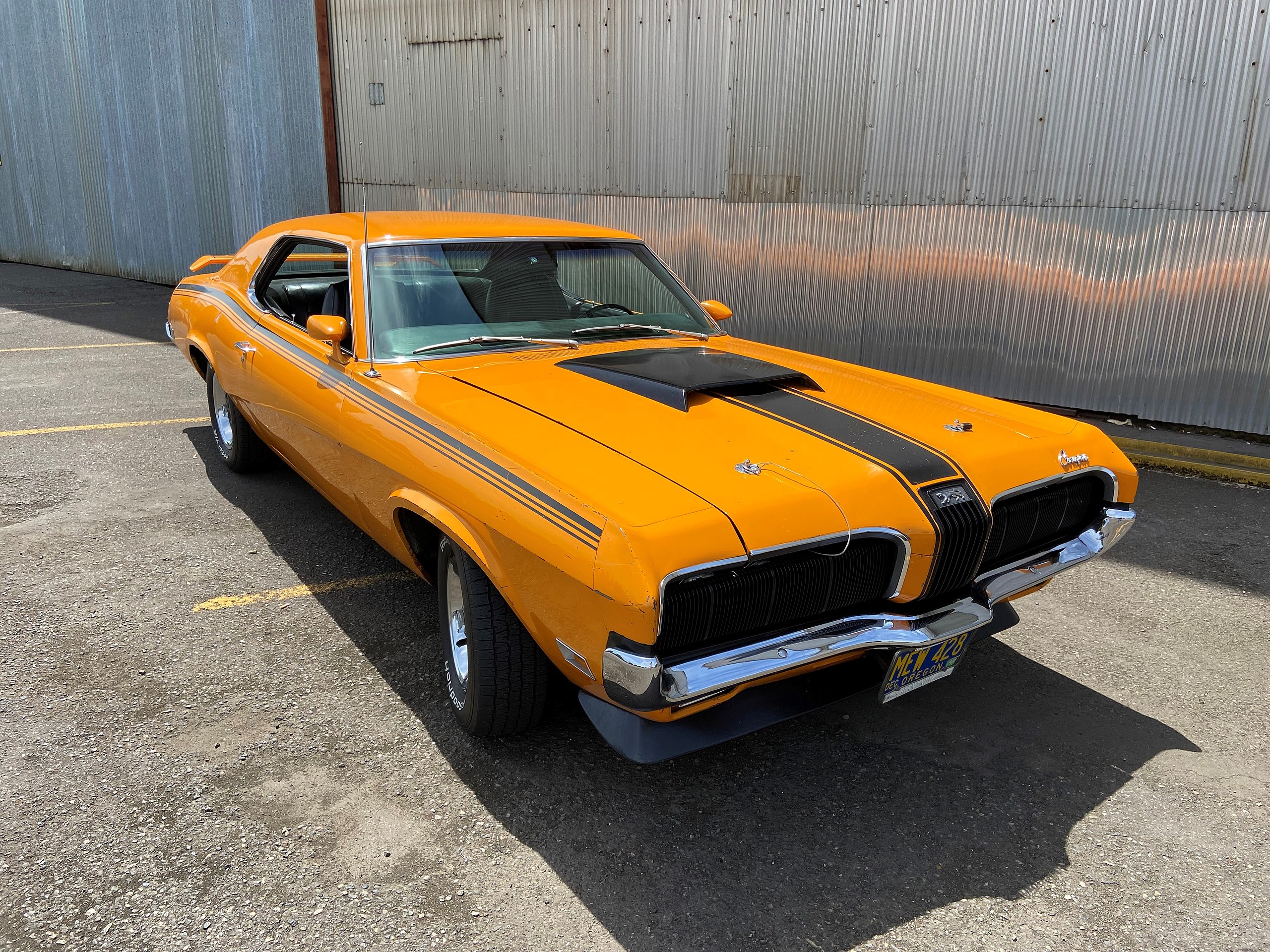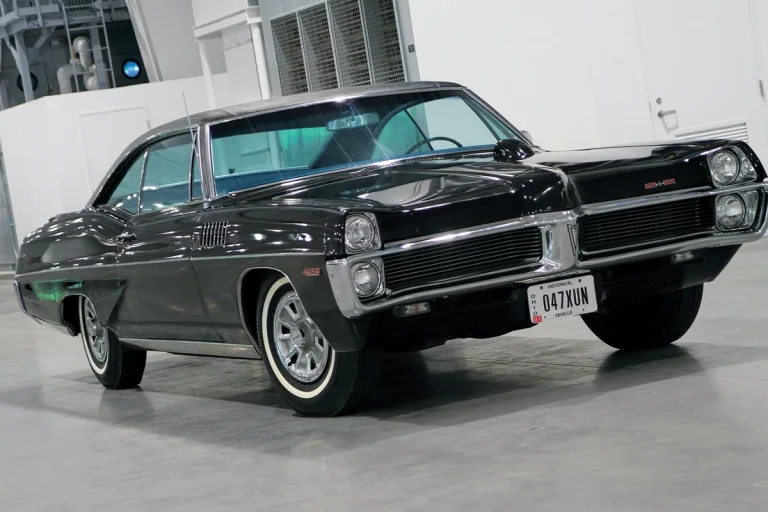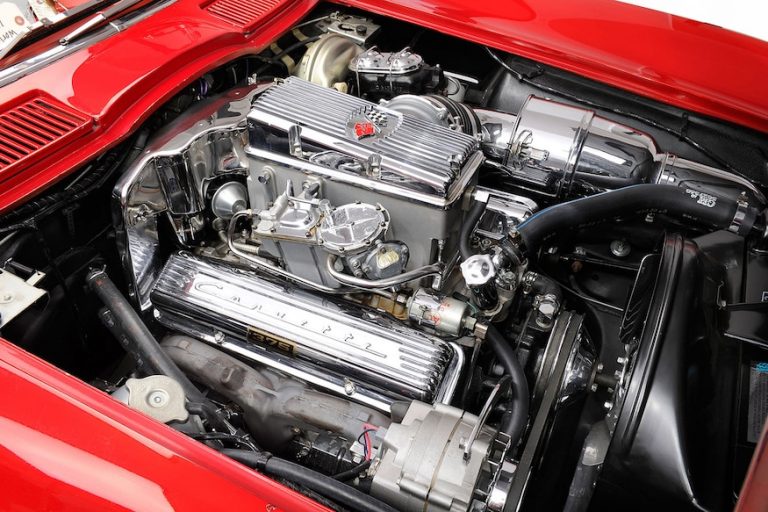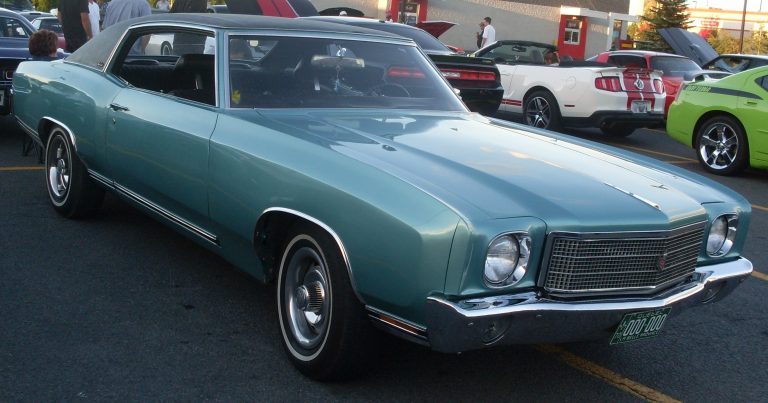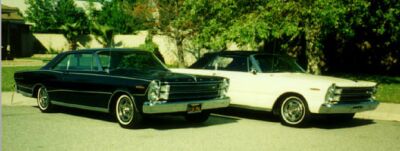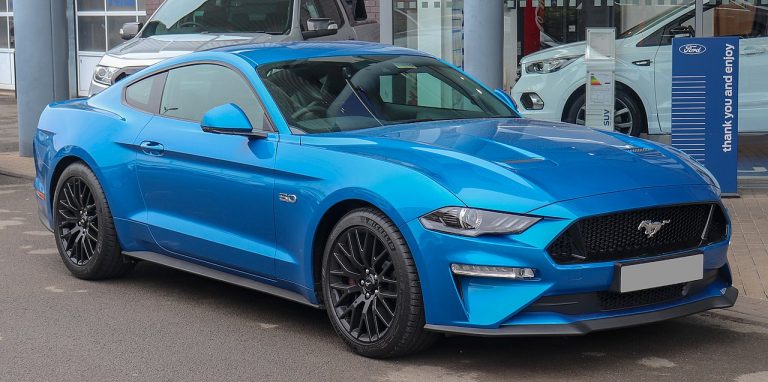Mercury Cougar

Meet Chandler
Chandler has a bachelors and masters degree in history as well as a passion for classics and muscle cars. His education and historical knowledge makes him skilled at crafting highly detailed articles about America’s muscle cars and automotive history. His love of muscle cars is undeniable, with him seeking them out at every opportunity during his visits to auto shows and car meets. Chandler’s knowledge and enthusiasm towards automotive history make him a great asset to the Muscle Car Club community.
From the mid-1960s to the mid-1970s, the Mercury Cougar was one of the top pony car options on the American market. Essentially a luxury version of the Ford Mustang, the Cougar was a top performer for Mercury and a solid ride. Its original run lasted from 1967–1997, before Ford briefly retired it for one model year. It returned for a final four-year swansong, but bit the dust for good after 2002. Today, enthusiasts fondly remember the Mercury Cougar as a luxury Mustang that got some of the best Ford performance engines of the day.
Mercury Cougar Overview
In all, the Mercury Cougar spanned eight generations from 1967–2002. From 1967–1973, during the first two generations, the Cougar was one of the top pony cars in America. Its main rivals were the Ford Mustang, Pontiac Firebird, Plymouth Barracuda, and Chevrolet Camaro, and it sold very well. In particular, the Cougar GT from 1967–1968 and the Cougar Eliminator from 1969–1970, were two incredible popular pony cars. They featured 390 and 428 cid V8 engines that put out an excess of 300 horsepower.
From 1974-on, Mercury developed the Cougar as a personal luxury car, making it slightly bigger. It switched its base from the Mustang to the Ford Thunderbird, which remained until 1997. From its debut, the Cougar was a success, winning the Motor Trend Car of the Year award for 1967. Though it never approached Mustang levels of success, it was still a popular car and a great luxury option from Mercury.
Mercury stocked the Cougar with big-displacement V8 engines at first, and they did not introduce a six-cylinder option until the ‘80s. Performance in the Cougars was solid through the second generation, after which things started to decline, big time. Much of this was due to emissions restrictions which necessitated drops in compression and power. By the mid-’80s, the Cougar was turbocharged and using electronic fuel injection, which helped it maintain steady sales.
The only year the Cougar did not appear during its run was in 1998, and it came back the next year in underwhelming form. Mercury finally gave the Cougar the ax after 2002 and eight generations, and Mercury itself closed its doors in 2011. Will Ford ever bring back the Cougar GT or Eliminator monikers? Only time will tell, but we can only hope.
First Generation 1967–1970 Mercury Cougar

The first generation of the Mercury Cougar lasted four model years from 1967–1970. The Cougar was basically Mercury’s counterpart to the Ford Mustang. In brochures, Mercury described the Cougar as “untamed elegance” and boasted about its European sports car inspiration. They called it “America’s first luxury sports car at a popular price,” and it was immediately a hit. In its first year alone, Mercury sold over 150,000 Cougars to eager customers.
For Ford buyers, it essentially bridged the gap between the sporty but cheap Mustang and the luxurious but expensive Thunderbird. Unique for the Cougar were disappearing headlights, wraparound fenders, bucket seats, and triple-sequential tail lights. Buyers had one body style available, a two-door hardtop coupe that sat five. They also had two options for trim packages: Either the XR-7 or the GT packages. The XR-7 had a medallion on the quarter-panel on the roof and woodgrain dashboard with a nicer interior than the base.
The GT package used a large 390 cid V8 engine and a firmer suspension with solid rear bushings, stiffer springs, bigger 1.1875 inch shocks, a fatter 0.84 inch anti-roll bar, power front disc brakes, 8.95×14 Wide-Oval tires, and a low-restriction exhaust system.
For the 1968 Mercury Cougar not much changed except new side marker lights, and the XR-7 became more distinguished. In the 1969 Mercury Cougar, a convertible became an option for the first time alongside the hardtop. That year, it also got a new grille, some new moldings, and a better interior, and it became bigger and heavier. For the final year of the first generation, the 1970 Mercury Cougar the hood got a center bulge and a new interior.
Mercury Cougar Eliminator
While the Mercury Cougar GT was a great option for 1967–1968, Ford dropped it in 1969 in favor of the GT-E and the new Cougar Eliminator. The Cougar Eliminator was built purely for drag racing, and it was very popular. It featured new tires, new rear gearing, spoilers, and a functional hood scoop (with the Ram Air Cobra Jet only). You could also get all kinds of goodies from the dealer, including Weber quad-carbs and more.
Unfortunately, Mercury only produced the Eliminator for two years from 1969–1970, before they dropped it. Today, Cougar Eliminators with the Boss 302 or 428 Cobra jets are very popular on the collector’s market, and even rival many Mustangs.
1967–1970 Mercury Cougar Engine Technical Specifications
| Model Years | Engine | Horsepower | Torque |
| 1967 | 289 cid V8 (2bbl) | 200 horsepower | 282 lb-ft |
| 1967 | 289 cid V8 (4bbl) | 225 horsepower | 305 lb-ft |
| 1967 | 390 cid V8 (4bbl) (Marauder GT) | 320 horsepower | 427 lb-ft |
| 1967 | 390 cid V8 (4bbl) | 335 horsepower | 427 lb-ft |
| 1968 | 302 cid V8 (2bbl) | 210 horsepower | 295 lb-ft |
| 1968 | 302 cid V8 (4bbl) | 230 horsepower | 310 lb-ft |
| 1968 | 390 cid V8 (4bbl) (Marauder) | 280 horsepower | 403 lb-ft |
| 1968 | 390 cid V8 (4bbl) (Marauder GT) | 325 horsepower | 427 lb-ft |
| 1968 | 427 cid V8 (4bbl) | 390 horsepower | 460 lb-ft |
| 1969-1970 | 351 cid V8 (2bbl) | 250 horsepower | 355 lb-ft |
| 1969 | 351 cid V8 (4bbl) | 290 horsepower | 385 lb-ft |
| 1969 | 390 cid V8 (4bbl) | 320 horsepower | 427 lb-ft |
| 1969-1970 | 428 cid V8 (4bbl) (Cobra Jet) | 335 horsepower | 440 lb-ft |
| 1969-1970 | 428 cid V8 (4bbl) (Cobra Jet RA) | 335 horsepower | 440 lb-ft |
| 1970 | 351 cid V8 (4bbl) | 300 horsepower | 380 lb-ft |
| 1970 | 302 cid V8 (4bbl) | 290 horsepower | 290 lb-ft |
1967–1970 Mercury Cougar Engines and Performance
For the inaugural year, the 1967 Mercury Cougar had two engines available at four different power levels. The 289 cid V8, the same used in the Mustang, put out either 200 horsepower with a two-barrel as the “Cougar 289,” while the four-barrel “Super Cougar 289” put out 225 horsepower. The Cougar had a 9.3 compression ratio while the Super Cougar jumped to 9.8:1. Both used hydraulic valve lifters.
The next step up was the Marauder 390 cid V8, which pumped out 320 horsepower. It used a Holley quad-barrel C70F car, and required premium octane fuel. The highest output one could get for 1967 was the 335 horsepower 390 V8. For the 1968 Mercury Cougar, new options included the Boss 302 V8 and the 427 Cougar V8. The Boss 302 made either 210 or 230 horsepower, courtesy of either a dual or quad-barrel carb.
Also in 1968, the Marauder V8 could be had with either a two or four-barrel carb, making either 280 or 325 horsepower. However, those all paled in comparison with the 427 cid V8 making 390 horsepower, 460 lb-ft of torque, with a Holley four-barrel and a 10.9:1 compression ratio. It was exclusively in the new Cougar GT-E models, as it was the E version of the 427 V8.
For the 1969 Mercury Cougar, Mercury replaced the 427 with the new 428 Cobra Jet V8. They also introduced a new 351 cid V8 to complement the 390 V8, as the Boss 302 was temporarily dropped. The 428 Cobra Jet was available with a Ram Air package, and made 335 horsepower. Two Cougars also got the 429 Cobra Jet, but those were not factory options.
1967–1970 Mercury Cougar Production Numbers
| Model Year | Bodystyle | Production Total |
| 1967 | Cougar | 123,672 |
| Cougar XR-7 | 27,221 | |
| 1967 Total | 150,893 | |
| 1968 | Cougar | 81,014 |
| Cougar XR-7 | 32,714 | |
| 1968 Total | 113,728 | |
| 1969 | Cougar Hardtop | 66,331 |
| Cougar Convertible | 5,796 | |
| XR-7 Hardtop | 29,918 | |
| XR-7 Convertible | 4,024 | |
| 1969 Total | 106,069 | |
| 1970 | Cougar Hardtop | 49,479 |
| Cougar Convertible | 2,322 | |
| XR-7 Hardtop | 18,565 | |
| XR-7 Convertible | 1,977 | |
| 1970 Total | 72,343 |
Second Generation 1971–1973 Mercury Cougar

The second generation of the Mercury Cougar lasted from 1971–1973. Styling changes for 1971 included a new front end, exposed and recessed headlights, signal lights that wrapped around the fenders, a Mercury hood ornament, triple pinstripes, and flow-through ventilation. The XR-7 got chrome rocker panels, new wheel covers, and a remote control racing mirror on the driver’s side. The car was also a little longer on the new 112 inch wheelbase.
For the 1972 Mercury Cougar, Ford updated the front end once again, but for the most part it continued to look the same through 1973. From 1971–1972, the GT package was still an option, but the GT-E and Eliminator options were both dropped. Production and enthusiasm was down markedly over the first generation, as beginning in 1970 sales had started to decline. In 1972, Mercury was making barely ⅓ of the Cougars they had been in 1967.
After 1973, the Cougar shifted from a pony car to a more luxury oriented sports car. It got even bigger and performance severely declined, though much of that was due to new emissions restrictions. You could no longer call it a pony car, and the big-block V8s produced pitiful performance. Compared with its brethren like the Mustang, Firebird, or Camaro, the Cougar could just not keep up with performance after 1973.
1971–1973 Mercury Cougar Engine Technical Specifications
| Model Years | Engine | Horsepower | Torque |
| 1971 | 351 cid V8 (2bbl) | 240 horsepower | 350 lb-ft |
| 1971 | 351 cid V8 (4bbl) | 285 horsepower | 370 lb-ft |
| 1971 | 429 cid V8 (4bbl) (Cobra Jet) | 370 horsepower | 450 lb-ft |
| 1972 | 351 cid V8 (2bbl) | 164 horsepower | 277 lb-ft |
| 1972 | 351 cid V8 (4bbl) | 246 horsepower | 301 lb-ft |
| 1972-1973 | 351 cid V8 (4bbl) (Cobra Jet) | 266 horsepower | 301 lb-ft |
| 1973 | 351 cid V8 (2bbl) | 168 horsepower | 266 lb-ft |
| 1973 | 400 cid V8 (2bbl) | 171 horsepower | 330 lb-ft |
| 1973 | 429 cid V8 (4bbl) | 198 horsepower | 350+ lb-ft |
| 1973 | 460 cid V8 (4bbl) | 267 horsepower | 350+ lb-ft |
1971–1973 Mercury Cougar Engines and Performance
For the 1971 Mercury Cougar, Ford kept the same 351 V8, and in 1972–1974 they used the 351 Cobra Jet version. The high-output 351 made 285 horsepower with a four-barrel carb, while the 1972–1973 Cobra Jet 351 made 266 horsepower. For 1971 only, the 429 Cobra Jet was an option, producing 370 horsepower and 450 lb-ft of torque. Mercury dropped the 429 in 1972, mainly due to emissions reasons.
To replace the Cobra Jet V8s, in 1973 Mercury brought out the 400, 429, and 460 V8s. The 429 was not the Cobra Jet version, but was a low-horsepower, high-torque monster. The biggest engine, the 460 Thunderbird V8, pumped out 267 horsepower and more than 350 lb-ft of torque. This was through a four-barrel carb, and power would drop significantly by the next year.
Much of the reason for Mercury dropping the big-block V8s and detuning their other engines was emissions. Emissions restrictions forced lower compression ratios, which hamstrung V8 engines from producing serious horsepower. Torque-on-demand was rarely a problem, but horsepower was really lacking.
In addition, Ford/Mercury changed their engine rating system. Previously, they used SAE Gross measurements, but after 1971 began using SAE Net measurements. The difference is that Net measurements require the engine to be tested with accessories, to mimic the real world. This results in more parasitic loss, which shows up in lower horsepower and torque numbers. So while the engines were detuned, they weren’t as pathetic as it may have seemed. Still, it was a tough pill to sell customers, especially when most of them began opting for smaller and more fuel efficient engines.
1971–1973 Mercury Cougar Production Numbers
| Model Year | Bodystyle | Production Total |
| 1971 | Cougar Hardtop | 34,008 |
| Cougar Convertible | 1,723 | |
| XR-7 Hardtop | 25,416 | |
| XR-7 Convertible | 1,717 | |
| 1971 Total | 62,864 | |
| 1972 | Cougar Hardtop | 23,731 |
| Cougar Convertible | 1,240 | |
| XR-7 Hardtop | 26,802 | |
| XR-7 Convertible | 1,929 | |
| 1972 Total | 53,702 | |
| 1973 | Cougar Hardtop | 21,069 |
| Cougar Convertible | 1,284 | |
| XR-7 Hardtop | 35,110 | |
| XR-7 Convertible | 3,165 | |
| 1973 Total | 60,628 |
Third Generation 1974–1976 Mercury Cougar
The third generation of the Mercury Cougar lasted from 1974–1976, and the Cougar was firmly a luxury car by this point. It got larger than the year prior, and now the XR-7 was the only trim available. The big change was the shift from the Mustang platform to the Montego/Torino intermediate platform. The 114 inch wheelbase was 2 inches longer than before, and it was now with body-on-frame construction.
Engine choices were relatively underwhelming, outside of the Cobra Jet that lasted through 1974. The other options were the 400 and 460 cid Thunderbird V8 engines from the year prior, though they were down on power. Sales were about the same, which was about half of what they had been in their ‘60s heydey.
1974–1976 Engine Technical Specifications
| Model Years | Engine | Horsepower | Torque |
| 1974 | 351 cid V8 (2bbl) | 168 horsepower | 266 lb-ft |
| 351 cid V8 (4bbl) (Cobra Jet) | 255 horsepower | 290 lb-ft | |
| 400 cid V8 (2bbl) | 170 horsepower | 330 lb-ft | |
| 460 cid V8 (4bbl) | 220 horsepower | 355 lb-ft | |
| 1975 | 351 cid V8 (2bbl) | 148 horsepower | 240 lb-ft |
| 400 cid V8 (2bbl) | 158 horsepower | 276 lb-ft | |
| 460 cid V8 (4bbl) | 216 horsepower | 366 lb-ft | |
| 1976 | 351 cid V8 (2bbl) | 152 horsepower | 274 lb-ft |
| 400 cid V8 (2bbl) | 180 horsepower | 336 lb-ft | |
| 460 cid V8 (4bbl) | 202 horsepower | 352 lb-ft |
1974–1976 Production Numbers
| Model Year | Bodystyle | Production Total |
| 1974 | Cougar XR-7 | 91,670 |
| 1975 | Cougar XR-7 | 62,987 |
| 1976 | Cougar XR-7 | 83,765 |
Fourth Generation 1977–1979 Mercury Cougar
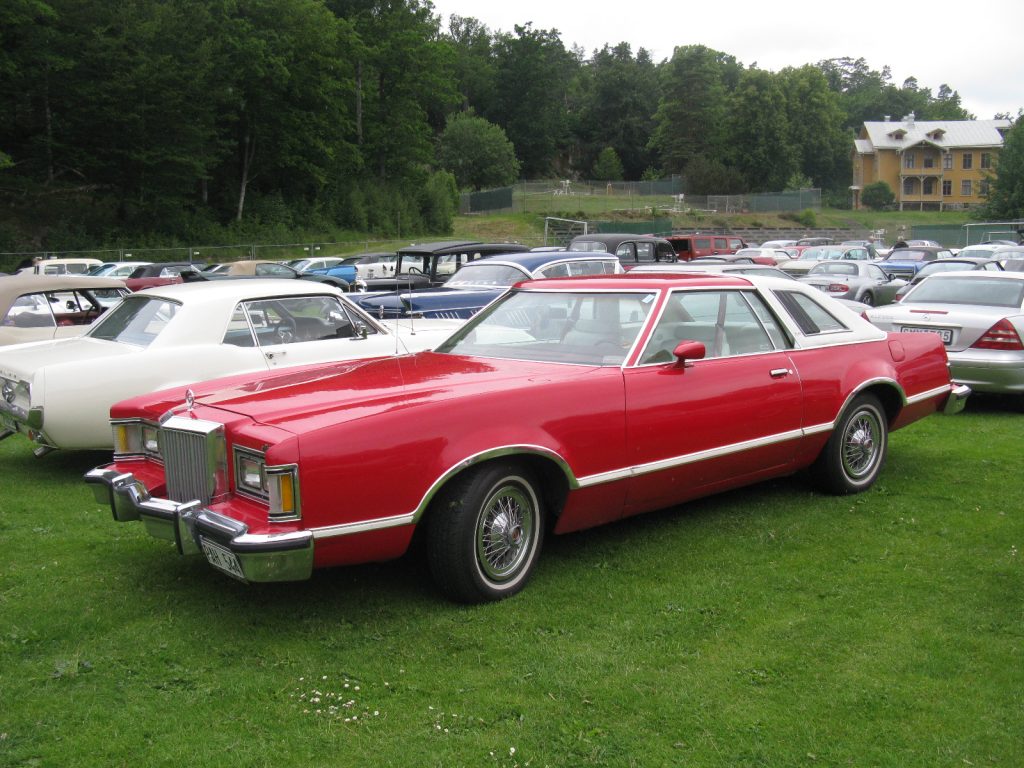
The fourth generation of the Cougar lasted from 1977–1979, and the Cougar XR-7 was basically the Mercury version of the Thunderbird now. The Cougar still resided on the same Torino wheelbase for the two-door coupe, but the four-door sedan and station wagons were even longer at 118 inch. The hood was incredibly long and massive, but the front end had a less pronounced bulge.
Engine wise, the 351 and 400 cid V8s remained, and the new 302 V8 briefly made an appearance. Performance was wholly underwhelming, and Mercury no longer really marketed the Cougar for power. It was all about luxury now, and sales made a considerable comeback. The fourth generation Cougar had by far the highest annual sales, which eclipsed 200,000 in 1978 for the first time ever.
1977–1979 Engine Technical Specifications
| Model Years | Engine | Horsepower | Torque |
| 1977 | 302 cid V8 (2bbl) | 130 horsepower | 242 lb-ft |
| 1977 | 351 cid V8 (2bbl) | 149 horsepower | 291 lb-ft |
| 1977 | 351 cid V8 (2bbl) | 161 horsepower | 285 lb-ft |
| 1977 | 400 cid V8 (2bbl) | 173 horsepower | 328 lb-ft |
| 1978-1979 | 302 cid V8 (2bbl) | 134 horsepower | 248 lb-ft |
| 1978 | 351 cid V8 (2bbl) | 145 horsepower | 273 lb-ft |
| 1978 | 400 cid V8 (2bbl) | 160 horsepower | 316 lb-ft |
| 1979 | 351 cid V8 (2bbl) | 135 horsepower | 260 lb-ft |
| 1979 | 351 cid V8 (2bbl) | 151 horsepower | 270 lb-ft |
1977–1979 Production Numbers
| Model Year | Bodystyle | Production Total |
| 1977 | Base | 36,117 |
| Brougham | 25,338 | |
| Villager | 8,569 | |
| XR-7 | 124,799 | |
| 1977 Total | 194,823 | |
| 1978 | Two-door Hardtop | 21,398 |
| Four-Door Hardtop | 25,364 | |
| XR-7 | 166,508 | |
| 1978 Total | 213,270 | |
| 1979 | Two-door Hardtop | 2,831 |
| Four-Door Hardtop | 5,605 | |
| XR-7 | 163,716 | |
| 1979 Total | 172,152 |
Fifth Generation 1980–1982 Mercury Cougar
The fifth generation of the Mercury Cougar lasted from 1980–1982, and for the first time the Cougar got smaller and lighter. It now resided on the Ford Foxbody platform, which was the same as the Thunderbird and Lincoln Continental. Engine choices were a 4.2 or 5.0 liter V8, or a 3.3 I6 or 3.8 V6. For the first time, a six-cylinder engine was standard, and the V8s were options. Power was completely lacking, even compared to the generation prior, and sales plummeted. After a brief 3-year whirlwind, things came back to earth in 1980–1982, and they would never really recover.
1980–1982 Mercury Cougar Engine Technical Specifications
| Model Years | Engine | Horsepower | Torque |
| 1980-1981 | 4.2 liter V8 (2bbl) | 115 horsepower | 195 lb-ft |
| 1980-1981 | 5.0 liter V8 (2bbl) | 130 horsepower | 235 lb-ft |
| 1981-1982 | 3.3 liter I6 (1bbl) | 88 horsepower | 154 lb-ft |
| 1982 | 3.8 liter V6 (2bbl) | 112 horsepower | 175 lb-ft |
| 1982 | 4.2 liter V8 (2bbl) | 120 horsepower | 205 lb-ft |
1980–1982 Mercury Cougar Production Numbers
| Model Year | Bodystyle | Production Total |
| 1980 | Cougar XR-7 | 58,028 |
| 1981 | Two-door Hardtop | 10,793 |
| Four-Door Hardtop | 42,860 | |
| XR-7 | 37,275 | |
| 1981 Total | 90,928 | |
| 1982 | Two-door Sedan | 6,984 |
| Four-Door Sedan | 30,672 | |
| Four-Door Wagon | 19,294 | |
| XR-7 | 16,867 | |
| 1982 Total | 73,817 |
Sixth Generation 1983–1988 Mercury Cougar
The sixth generation of the Cougar lasted from 1983–1988, and saw the body style get even sleeker. Smooth lines replaced square, but it still rode on the Ford Fox platform. The Cougar was one of the first vehicles to be designed with the aid of CAD, which helped reduce the drag coefficient.
The same 5.0 and 3.8 liter engines returned, but new was a 2.3 liter turbocharged inline-4. It produced 145–155 horsepower, and was a fun little engine. It was the same engine as in the Thunderbird Turbo Coupe, but only lasted until 1986. In 1983, electronic fuel injection came to the Cougar, first in the 5.0 V8, and then in the 3.8 V6. Eventually, sequential fuel injection and multi point fuel injection became standard by 1986. Power was still down, but it was an improvement over the prior generation.
1983–1988 Mercury Cougar Engine Technical Specifications
| Model Years | Engine | Horsepower | Torque |
| 1983 | 3.8 liter V6 (2bbl) | 112 horsepower | 175 lb-ft |
| 1983 | 5.0 liter V8 (EFI) | 130 horsepower | 240 lb-ft |
| 1984 | 2.3 liter I4 (1bbl) (Turbocharged) | 145 horsepower | 180 lb-ft |
| 1984-1987 | 3.8 liter V6 (EFI) | 120 horsepower | 205 lb-ft |
| 1984-1985 | 5.0 liter V8 (EFI) | 140 horsepower | 250 lb-ft |
| 1985-1986 | 2.3 liter I4 (1bbl) (Turbocharged) | 155 horsepower | 190 lb-ft |
| 1986-1987 | 5.0 liter V8 (SEFI) | 150 horsepower | 270 lb-ft |
| 1988 | 3.8 liter V6 (MPFI) | 140 horsepower | 215 lb-ft |
| 1988 | 5.0 liter V8 (SEFI) | 155 horsepower | 265 lb-ft |
1983–1988 Mercury Cougar Production Numbers
| Model Year | Bodystyle | Production Total |
| 1983 | Cougar & XR-7 | 75,743 |
| 1984 | Cougar & XR-7 | 131,190 |
| 1985 | Cougar & XR-7 | 117,274 |
| 1986 | Cougar & XR-7 | 135,909 |
| 1987 | Cougar & XR-7 | 104,526 |
| 1988 | Cougar & XR-7 | 119,162 |
Seventh Generation 1989–1997 Mercury Cougar
The seventh and penultimate generation of the Cougar lasted from 1989–1997. Mercury changed the chassis from the Fox Body to the new MN12 chassis, which made it slightly longer than before. The car was sleeker and rounder than before, with a long raked windshield and long hood. Available engines were the same 3.8 V6 and 5.0 V8, but a new supercharged version of the 3.8 could now be bought. It pumped out 210 horsepower, which was the first time the Cougar broke 200 horsepower since the mid-’70s.
The 5.0 liter V8 jumped to 225 horsepower from 1991–1992, which finally made it worthwhile as an option again. It was fuel injected and made 275 lb-ft of torque, which was actually slightly less than the supercharged V6. Mercury dropped the 5.0 after 1993, leaving just the 3.8 V6 and 4.6 V8.
1989–1997 Mercury Cougar Engine Technical Specifications
| Model Years | Engine | Horsepower | Torque |
| 1989-1995 | 3.8 liter V6 (MPFI) | 140 horsepower | 215 lb-ft |
| 1989-1990 | 3.8 liter V6 (MPFI) (Supercharged) | 210 horsepower | 315 lb-ft |
| 1991-1992 | 5.0 liter V8 (SEFI) | 225 horsepower | 275 lb-ft |
| 1993 | 5.0 liter V8 (SEFI) | 200 horsepower | 275 lb-ft |
| 1994-1995 | 4.6 liter V8 (SEFI) | 205 horsepower | 265 lb-ft |
| 1996-1997 | 3.8 liter V6 (MPFI) | 145 horsepower | 215 lb-ft |
| 1996-1997 | 4.6 liter V8 (SEFI) | 205 horsepower | 280 lb-ft |
1989–1997 Mercury Cougar Production Numbers
| Model Year | Bodystyle | Production Total |
| 1989 | Cougar & XR-7 | 92,702 |
| 1990 | Cougar & XR-7 | 76,467 |
| 1991 | Cougar & XR-7 | 60,564 |
| 1992 | Cougar & XR-7 | 46,982 |
| 1993 | Cougar XR-7 | 79,700 |
| 1994 | Cougar XR-7 | 71,026 |
| 1995 | Cougar XR-7 | 60,201 |
| 1996 | Cougar XR-7 | 38,929 |
| 1997 | Cougar XR-7 | 35,267 |
Eighth Generation 1999–2002 Mercury Cougar

The final generation of the Mercury Cougar lasted from 1999–2002 after a brief 1 year hiatus. Mercury once again completely changed platforms, with the Cougar now residing on the CDW27 Platform. It looked nothing like the Cougar of old, with no iconic flat rear deck, but the wraparound head lights remained. Engines were very underwhelming, with just a 12 horsepower I4 or a 170 horsepower V6 Duratec.
Sales were okay for the 1999 Mercury Cougar, but dropped by half by the next year. In 2002, the Cougar had its worst year for sales, continuing a downward trend over the prior generations. In 2002, Mercury released the last Cougar, and it has not reappeared since. With the closing of Mercury in 2011, a new Cougar was not to be, though Ford may still revive it sometime in the future.
1999–2002 Mercury Cougar Engine Technical Specifications
| Model Years | Engine | Horsepower | Torque |
| 1999-2002 | 2.0 liter I4 | 125 horsepower | 130 lb-ft |
| 1999-2002 | 2.5 liter V6 | 170 horsepower | 165 lb-ft |
1999–2002 Production Numbers
| Model Year | Bodystyle | Production Total |
| 1999 | Cougar | 88,288 |
| 2000 | Cougar | 44,935 |
| 2001 | Cougar | 25,044 |
| 2002 | Cougar | 18,321 |
Mercury Cougar FAQ
The Mercury Cougar was in production from the 1967–1997 model years, and the 1999–2002 model years.
The best Mercury Cougar was the 1969 Mercury Cougar Eliminator with the 428 Cobra Jet Ram Air. It produced 335 horsepower and 440 lb-ft of torque and was fantastic.

